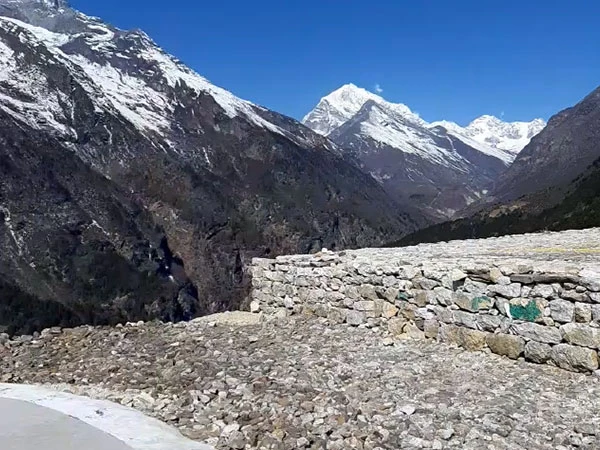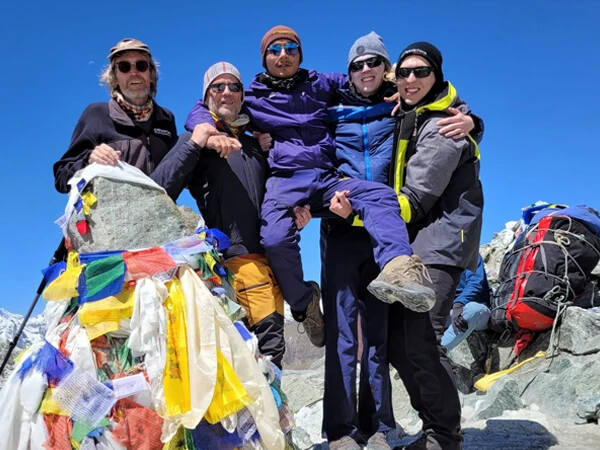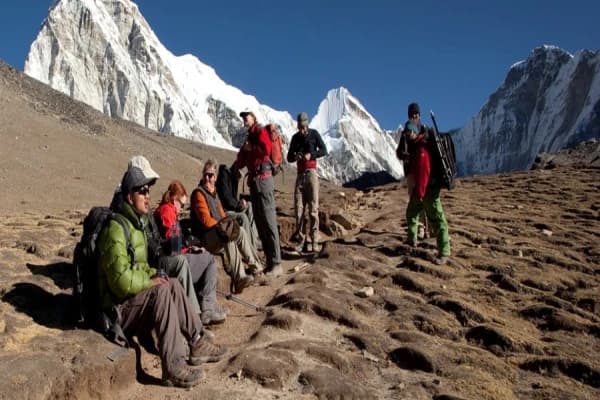The EBC Trek is Nepal’s most famous trekking route and among the most iconic journeys in the world.The Everest Base Camp trek distance and altitude are two key factors that every trekker should think about when preparing their journey. The adventure kicks off in Lukla, a small Himalayan town sitting at 2,860 meters (9,383 ft). From there, the trail winds through rugged terrain and breathtaking landscapes for about 130 kilometers (80 miles) round trip. The ultimate highlight is standing at Everest Base Camp itself, located at 5,364 meters (17,598 ft).
If you’ve ever wondered, “How far is Everest Base Camp from Lukla?”The answer is roughly 65 kilometers (40 miles) one way. Most trekkers complete the journey in 10 to 16 days, with plenty of time built in for rest, exploration, and acclimatization. On average, you’ll be hiking between 8 to 15 kilometers (5 to 9 miles) per day, depending on the stage of the trek and your walking pace.
Because of the Everest Base Camp trek altitude, acclimatization is a must. Rest days at Namche Bazaar (3,440 m/11,286 ft) and Dingboche (4,410 m/14,469 ft) are essential to let your body adjust to the thinning air. These stops make the journey safer and far more enjoyable.
Along the way, you’ll pass through welcoming Sherpa villages, ancient monasteries, and lush forests before the scenery shifts into rocky paths and snow-capped peaks. Many trekkers also add a climb to Kala Patthar (5,545 m/18,192 ft) for jaw-dropping views of Mount Everest.
The height of Everest Base Camp is what makes this trek so unique and rewarding. Yes, it’s challenging, but with the right preparation, pacing, and mindset, every step of the journey feels worthwhile.
Here is a brief information on Daily walking distance and duration on your Everest base camp trek Starting from Lukla:
| Day | Distance Segment |
Distance covered per Day (km) |
Duration (hr) |
| 1 |
Lukla – Phakding |
8 KM | 3-4 hrs |
| 2 |
Phakding – Namche Bazaar |
12.3 KM | 5-6 hrs |
| 3 | Namche Bazaar | 7.2 KM | 4-5 hrs |
| 4 |
Namche Bazaar – Tengboche |
10.7 KM | 5-6 hrs |
| 5 | Tengboche – Dingboche | 10.8 KM | 5-6 hrs |
| 6 | Dingboche | 5.2 KM | 4-5 hrs |
| 7 | Dingboche – Lobuche | 8.8 KM | 5-6 hrs |
| 8 | Lobuche – Everest Base Camp – Gorakshep | 11.5 KM | 8-9 hrs |
| 9 |
Gorakshep – Kalapatthar – Periche |
17.2 KM | 8-9 hrs |
| 10 | Periche – Namche Bazaar | 19.7 KM | 7-8 hrs |
| 11 |
Namche Bazaar – Lukla |
19.9 KM | 8-9 hrs |
Altitude Gain per Day on Everest Base Camp Trek
The Everest Base Camp Trek is a journey of steadily increasing altitude, which makes it essential to understand both the distance and elevation gains before heading out. While the trek isn’t technical, it is a long journey that takes you through different villages and landscapes, with continuous climbs, ascents and descents.
Your adventure begins in Kathmandu at 1,350 m, though no trekking is done on the first day. The following morning, a short but thrilling flight takes you to Lukla (2,840 m), the gateway to the Khumbu region. From here, you start trekking downhill to Phakding (2,610 m), losing about 230 min altitude.
The trail then climbs steeply to Namche Bazaar (3,440 m), an elevation gain of 830 m. Namche serves as a vital acclimatization stop, where trekkers often spend an extra day and hike up to the Everest View Hotel (3,880 m) for panoramic mountain views and to help the body adjust to the thinner air.
From Namche, the trek continues to Tengboche (3,860 m), famous for its monastery and mountain vistas, with a gain of 420 meters. The next stretch takes you to Dingboche (4,410 m), climbing another 550 meters. Another acclimatization day here allows for side hikes, such as to Nagarjun Hill (5,100 m), which helps prepare for the higher altitudes ahead.
The path then leads to Lobuche (4,940 m) with an elevation gain of 530 meters, and onward to Gorak Shep (5,170 m), the last settlement before reaching the legendary Everest Base Camp at 5,364 m. This marks the high point of the trek and the moment most trekkers dream of.
For those seeking even better views of Everest, a sunrise hike to Kala Patthar (5,545 m) is a must. From Gorak Shep, this climb adds another 375 meters but rewards you with the most breathtaking panorama of Mount Everest and the surrounding peaks. Afterward, the descent begins, dropping down to Pangboche (4,010 m) with a steep loss of 1,535 m. From there, the trail continues down to Namche Bazaar and eventually back to Lukla, before flying once again to Kathmandu.
In total, the trek involves an altitude gain of more than 2,500 meters from Lukla to Base Camp. The gradual pace, acclimatization days, and careful itinerary are all designed to reduce the risk of altitude sickness and ensure that trekkers can safely enjoy this once-in-a-lifetime adventure.
What are the Alternative routes to Everest Base Camp Trek?
If you are looking to trek EBC in a short time then the popular route of classic EBC trek is the best route for you. While trekking via Jiri takes comparatively longer. For an adventurous one, trekking EBC via Gokyo Ri is the best option.
Classic Everest Base Camp Trek
It is the shortest, popular and straightforward route to EBC. In this route the journey starts from flight to Lukla and then direct trekking to EBC and back. It takes approximately 12 to 16 days to complete this trek.
If you are a first-time trekker then this is the ideal route for you, as it features a more straightforward and well-traveled path. It also includes the iconic Kala Patthar viewpoint which gives the best and unique perspective of Everest.
Overall this route is best for novice trekkers, those with less leisure time, those looking to explore popular routes and finally for those looking for less challenging adventures to Everest Base Camp.
Everest Base Camp Trek Via Jiri
It is a longer version route to Everest base camp. It especially has more opportunities for cultural immersion to trekkers. The trek starts from Jiri to EBC and back to Kathmandu. It takes approximately 26 days to complete the journey from this route.
The trek begins at a lower altitude, providing a more gradual acclimatization and a soft start to the journey. It offers a deeper cultural experience by passing remote and cultural villages along with traditional farming areas before joining the classic trail to EBC.
If you want to avoid flying to Lukla, this is the best alternative for you and those with extra time.
Overall this route is ideal for those seeking a more authentic and cultural experience during their journey, who have more time and a desire for a gradual acclimatization.
Everest Base Camp Trek Via Gokyo Ri
It is another longer, adventurous and scenic route to EBC. The journey typically starts with a flight to Lukla and involves a circuit through Gokyo, Cho La Pass, and EBC. This is also known as an extension version of the classic EBC trek which often takes around 12 to 15 days for completion.
This route features the iconic and breathtaking Gokyo Lakes, which is a series of turquoise glacial lakes offering stunning views along with panoramic vistas of majestic peaks like Everest, Lhotse and Cho Oyu. It also involves crossing the challenging Cho La Pass, which is one of the main “Three high passes.”
Despite being an extension version of the Classic EBC trek, it is comparatively more complex and has rugged terrain. Which is why it is best for experienced trekkers who are seeking more adventure, stunning lake views, challenging passes and lesser crowds.
How Difficult is Everest Base Camp trek in terms of Altitude and Distance?
The primary challenges on the EBC trek are altitude sickness and the strenuous distances and terrain, which combine to make the trek a physically demanding experience. But with the right preparation, it’s achievable for most people.
Whether you’re a beginner taking on your first big trek or an experienced adventurer looking for a rewarding challenge. While it doesn’t involve technical climbing, it does require long days of walking on steep, uneven trails with significant altitude gains, making it physically demanding.
The biggest hurdle is the Everest Base Camp trek altitude. Starting from 2,840 meters in Lukla, the trail climbs to 5,364 meters at Base Camp. As the air thins, the risk of altitude sickness increases, which is why the itinerary is designed with acclimatization days to give your body time to adjust.
The route itself can be rocky and steep in sections, and higher up, the weather often turns cold and windy. Trekkers usually spend 5 to 8 hours a day on the trail, covering distances that test both endurance and determination.
That said, with a reasonable level of fitness, the right gear, and a steady pace, most people find the trek very manageable and doable. It’s a demanding journey, yes, but the incredible mountain views, vibrant Sherpa culture, and the achievement of standing at Everest Base Camp make every step worthwhile.
How to prepare for Everest Base Camp Trek?
We strongly recommend spending 3 nights in Namche Bazaar (11,300 ft) on your way to Everest Base Camp. All of our trekking itineraries are designed with this extra acclimatization time built in. Taking those additional nights in Namche is one of the most important steps you can take for both your safety and success on the trail as it gives your body the chance to adjust properly to the altitude and makes the rest of the journey far more enjoyable.
Everyone has different concerns and questions, so feel free at any stage of reading this information to pick the phone or email us with your specific questions. Here are some effective ways you can prepare for your Everest Base Camp Trek:
Highly Prioritize Acclimatization
The most important factor for a safe and successful Everest Base Camp trek is allowing plenty of time for acclimatization. We strongly recommend you to include enough acclimatization stops in the itinerary. Time spent at this elevation (at Namche Bazaar) gives your body a chance to adjust to the thinner air, produce more red blood cells, and carry oxygen more efficiently, i.e., helping you move safely to higher altitudes.
Not everyone makes it high into the Everest region, which is why proper acclimatization at lower elevations is critical. From years of experience, we know that skipping on acclimatization significantly increases the risk of acute mountain sickness (AMS). Taking the recommended time to acclimatize doesn’t just make the trek safer as it also dramatically improves your chances of reaching Everest Base Camp and enjoying the journey.
Build The Right Training Plan For You
Start preparing for your Everest Base Camp trek at least 3 to 6 months in advance. If you don’t have access to mountains, just focus on building strength, endurance, and cardiovascular fitness through activities like hiking, stair climbing, running, or weighted walks. A successful training plan depends on understanding the daily distances, elevation gains, and the weight of your backpack, so you can simulate similar conditions before the trek.
Equally important is mental preparation. Long days, changing weather, and high altitude can be challenging, so developing resilience and a positive mindset will make the journey more enjoyable. Regular training, combined with proper nutrition, hydration, and rest, will ensure your body and mind are ready for the adventure, helping you fully enjoy the stunning landscapes and the experience of reaching Everest Base Camp.
Right Choice of Clothing
Having the right gear is essential for a comfortable and safe Everest Base Camp trek. A good sleeping bag, sturdy trekking boots, and quality layers like merino wool can make a huge difference, especially since you’ll spend a lot of time resting and sleeping between hikes.
A high-quality down sleeping bag, rated to around 0°F (-17°C), can mean the difference between restless nights and deep, restorative sleep. Along with that, you’ll need the right layers, a warm down jacket, gloves, trekking boots, a reliable backpack, and a few smaller key items.
When you sign up for one of our trips, our team is always available to help you make the best choices for clothing and equipment, ensuring you’re fully prepared for the trek.
Eat Balance Diet
At Ammonite Adventure, we use the best lodges available along the route, and the quality of your accommodation often directly affects the quality of your meals. While food in the region can sometimes feel repetitive, we make sure to provide the best possible options at the best lodges to keep you well-fueled for your trek.
Proper nutrition is essential for your Everest Base Camp adventure, so choosing a trek with subpar lodges and cheap options can increase the risk of food-related issues and make the journey less enjoyable. We focus on comfort, quality, and safety to ensure you have the energy you need for every day on the trail.
Stay Hydrated
Proper hydration is essential before and during your Everest Base Camp trek. Start by drinking plenty of water even before arriving in Nepal. Once on the trail, aim for 4 to 5 liters of water per day, as staying hydrated is critical in the low-oxygen environment at high altitude. Protecting yourself from the sun and avoiding sunburn are equally important on any high-altitude trek.
On our trips, we make hydration easy and structured. Each morning, the goal is to drink one liter of water before starting the hike, usually around 8 a.m. During breakfast, our staff will fill your 2–3 liter hydration system (bladder) so you can sip water throughout the morning trek. By lunchtime, you’ll ideally have consumed around three liters.
At lunch, you can top up with another liter or two to carry you through the afternoon section of the hike. By the time you reach your lodge in the evening, you should have consumed 4–5 liters of water for the day. This approach keeps you well-hydrated while avoiding late-night trips to the bathroom, helping you rest and recover for the next day on the trail.
Emergency Helicopter Evacuation Access
On all our trips, every team carries satellite phones to stay connected, even when cell coverage is unavailable. We also strongly recommend having evacuation coverage for the trek. If there’s ever a concern for your safety, our team will act quickly to get you to a lower elevation.
We monitor your oxygen saturation daily and track your progress to ensure you’re coping well with the altitude. If we notice clear signs of acute mountain sickness (AMS) or any serious difficulty, we won’t hesitate to assist you and get you off the mountain safely.
It’s important to remember that there are no roads in or out of this region. If you can’t walk back to Lukla to catch a flight, a helicopter is the only way out. This is a critical safety factor to consider, so make sure you have the proper coverage from your insurance before starting your trek.
Pick The Best Season To Trek
Choosing the right time to trek to Everest Base Camp can make a big difference to your experience. By keeping our teams small, you’ll enjoy better access to our staff, and our guides who will have the time to get to know you personally. This means they can spot even the slightest signs of altitude-related issues and respond quickly, keeping you safer on the trail. Smaller groups also create a more relaxed atmosphere, making the journey more enjoyable for everyone. From our experience, a maximum of 10 trekkers per team leads to the most successful and rewarding adventures.
There are two main trekking seasons to consider: pre-monsoon (March–May) and post-monsoon (September–December). The busiest times are usually April, May, and October, when the trails are at their most crowded. For those who prefer fewer people on the path, March, September, November, and December are excellent alternatives that still offer incredible trekking conditions.
Seek Out Professional Advice
Our team is ready to share professional, first-hand advice and insights that could be the key to turning your trek into a success.
Trek with Professionals
The team of Ammonite Adventure is here to provide you with everything you need to know for your Everest Base Camp trekking adventure. With over 40 successful EBC treks under our belt and a team who have each walked the trail many times, we know the route inside and out.
If you’d like expert advice or guidance, just give us a call or email us. We’ll be happy to share the right information to help you prepare for your journey to Everest Base Camp.
On a Concluding note,
The Everest Base Camp trek is a challenging but incredibly rewarding adventure. With proper preparation, acclimatization, and the right mindset, anyone can experience the breathtaking beauty of the Himalayas and the unforgettable moment of standing at Base Camp.
Take your time, pace yourself, and enjoy every step of this once-in-a-lifetime journey because your effort will be met with views and memories you’ll treasure forever.
Feel free to contact us at www.ammoniteadventure.com where we help you arrange your unforgettable journey to Himalayas.
Happy Trekking!!









